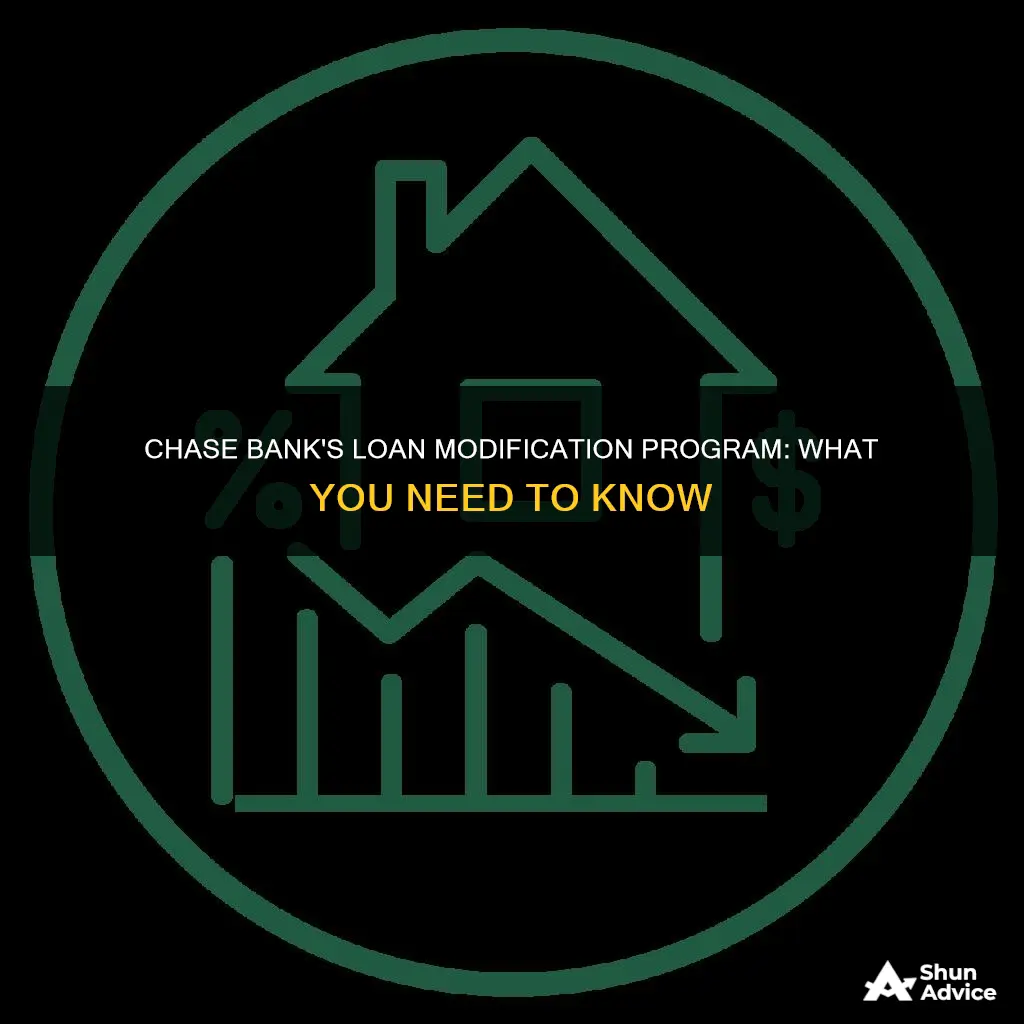
Chase offers loan modification programs to help eligible borrowers who are having trouble making their mortgage payments. The bank will review your loan for options such as a repayment plan, forbearance, or a loan modification. If you're eligible for a modification, Chase may offer a Trial Period Plan with a lower payment amount for three to four months. After this period, your mortgage will be permanently modified, and you'll receive the new terms of your loan, including the new payment amount. Chase also has an in-house modification program called CHAMP (Chase Home Modification Program) for those who aren't eligible for the government's HAMP (Home Affordable Modification Program). While getting a loan modification with Chase can be challenging, working with a knowledgeable professional can improve your chances of success.
| Characteristics | Values |
|---|---|
| Bank | Chase |
| Modification type | Mortgage loan modification |
| Modification programs | HAMP (Home Affordable Modification Program), CHAMP (Chase Home Modification Program) |
| Modification requirements | Difficulty making mortgage payments, defaulted or in danger of defaulting, mortgage obtained on or before January 1, 2009, property not condemned, primary residence debt up to $729,750 |
| Application process | Requires significant paperwork, may need to be submitted multiple times, may negatively impact credit score |
| Alternative options | Mortgage forbearance, repayment plan with lender, Refinancing |
What You'll Learn

Chase's in-house modification program, CHAMP
Chase offers a loan modification program called the Chase Home Modification Program, or CHAMP. This program is designed to help homeowners who are struggling to make their monthly mortgage payments or have defaulted on their loans. A loan modification can bring down the monthly payment to an affordable portion of the income, helping the borrower avoid foreclosure and return the loan to normal servicing.
CHAMP is not a government program, so Chase sets its own requirements. The basic eligibility requirements are similar to those of the government's Home Affordable Modification Program (HAMP). To be eligible for HAMP, borrowers must be having difficulty making their mortgage payments due to a valid hardship, be in danger of falling behind or have defaulted on their mortgage, have taken out their mortgage on or before January 1, 2009, not have their property condemned, and owe up to $729,750 on their primary residence. If a borrower is not eligible for HAMP, Chase will review them for CHAMP.
The application process for a loan modification with Chase can be challenging and requires a lot of paperwork. Homeowners may need to submit the same documents multiple times, as they can expire during the review process. After submission and review, the application may still be denied. Working with an experienced professional can help increase the chances of a successful application.
A loan modification with Chase involves making a permanent change to one or more of the loan's terms. This can include lowering the interest rate, extending the term length, or forgiving or restructuring the principal to bring down the payment amount. It's important to note that a loan modification may result in the borrower paying more for their home over the life of the loan, especially if the modification extends the loan term.
Chapel Hill Library: WiFi Loan Availability and Details
You may want to see also

Loan modification difficulties
Loan modification is a permanent change to the terms of your original loan. It is intended to make payments more affordable for borrowers facing financial hardship. However, there are some difficulties that borrowers may face when applying for a loan modification.
Firstly, not all lenders offer loan modifications. It is important to contact your lender to discuss your options and determine if loan modification is a possibility. Even if a lender offers loan modifications, there is no guarantee that your application will be approved. Each lender has its own eligibility requirements, which may include demonstrating significant financial hardship and that lower payments will help you keep up with your repayment plan. You may also need to show that you have missed or are at risk of missing a payment. Lenders will typically review your credit history, other debts, income, and other financial resources when considering your application. This process can be time-consuming and challenging, as you will need to provide a significant amount of documentation.
Additionally, even if you are approved for a loan modification, it may not necessarily solve your financial difficulties. For example, if your modification extends the length of your loan, you may end up paying more interest over the life of the loan. It is important to carefully consider the potential impact of any loan modification on your future financial plans.
Centrelink Loans: Are They Available and How to Get Them?
You may want to see also

Government assistance programs
The US federal government offers assistance to borrowers through several programs. The Home Affordable Modification Program (HAMP) is a government initiative that offers reduced monthly mortgage payments to homeowners at risk of foreclosure. HAMP is a voluntary program that supports servicers' efforts to modify mortgages while protecting taxpayers' interests. HAMP has also encouraged private lenders to modify mortgages without burdening taxpayers. HAMP's basic eligibility requirements include:
- Having difficulty making mortgage payments due to a valid hardship
- Defaulting or being in danger of falling behind on your mortgage
- Having a primary residence worth up to $729,750
- Obtaining your mortgage on or before January 1, 2009
- Ensuring your property has not been condemned
The Federal Housing Administration (FHA) also offers a program for borrowers with negative equity. The FHA Short Refinance program helps borrowers who are current on their mortgage payments but owe more than their home's worth. It provides an opportunity to transition to a more affordable FHA-insured mortgage by reducing the principal balance and payment.
Additionally, the U.S. Department of Veterans Affairs (VA) provides assistance to veteran borrowers in delinquency through the VA HAMP program. Military veterans can also receive mortgage delinquency counselling through the VA.
Fannie Mae, a government-sponsored mortgage company, offers the Flex Modification program. This program is designed to assist borrowers who are struggling to make their mortgage payments and are at risk of foreclosure.
Furthermore, the Hardest Hit Fund (HHF) programs complement the Making Home Affordable Program. These initiatives provide loan modification, mortgage payment assistance, and transition assistance to eligible struggling homeowners in 18 states and the District of Columbia.
Name Changes: Impact on Loan Eligibility and Identity Verification
You may want to see also

Temporary vs. permanent loan modifications
Chase is one of the "big four" banks and offers loan modification programs to its customers. As a recipient of bailout money from the government, Chase is required to evaluate eligible homeowners for the government's modification program, HAMP (Home Affordable Modification Program). If you're not eligible for HAMP, Chase will review you for their in-house modification program, CHAMP (Chase Home Modification Program).
Loan modifications are a permanent change to the terms of your original loan. The purpose of a loan modification is to make payments more affordable for borrowers in financial hardship. A loan modification may entail extending the term length of the mortgage, obtaining a lower interest rate, or changing loan types. For example, a modification may include switching from a loan with an adjustable rate to one with a fixed rate.
In the case of a permanent modification, a lender may require an entire year, or even two years, of on-time loan payments before the borrower can qualify for a new mortgage. A loan modification can negatively impact a person's credit score. However, lenders should explain to borrowers that a dip in their credit score is not as damaging as a foreclosure would be.
If your financial circumstances are temporary, your lender may be able to offer you a mortgage forbearance. This is a temporary pause or reduction in payment instead of modifying the loan permanently. These programs are specifically for those who have only a temporary change in their circumstances but will be able to resume their regular repayments after a short period.
Chapter 7: Wiping Out Loans and Debts
You may want to see also

Loan modification and credit score
Chase is one of the "big four" banks and offers mortgage services. As a recipient of bailout money from the government, Chase is required to evaluate eligible homeowners for the government's modification program, HAMP (Home Affordable Modification Program). If you are not eligible for HAMP, Chase will review you for their in-house modification program, CHAMP (Chase Home Modification Program).
Loan modification can affect your credit score in several ways, both positively and negatively, depending on your specific circumstances. Here are some key points to consider:
Negative Impact on Credit Score:
- Missed payments: Loan modifications are often available to borrowers who have already missed payments or are close to defaulting. Even one missed payment can significantly damage your credit score.
- Reported as a settlement: Lenders may report your loan modification as a settlement to credit bureaus, which can negatively impact your credit score for several years.
- Temporary financial relief: Applying for a loan modification may indicate financial distress, leading to a temporary drop in your credit score.
- Extended repayment period: Modifying your loan by extending the repayment period can increase the total interest paid over the loan's life, potentially affecting your creditworthiness.
- Foreclosure prevention: While loan modifications can help prevent foreclosure, which severely damages your credit score, the modification itself may also have a negative impact.
Positive Impact on Credit Score:
- Affordable payments: Loan modifications make payments more manageable, helping you avoid falling behind on payments, which can damage your credit score.
- Long-term improvement: If loan modifications make it easier for you to keep up with payments, maintaining a positive payment history can improve your credit score over time.
- Less severe impact: While a loan modification may negatively affect your credit score, its impact will likely be less severe and shorter-lasting than a foreclosure or defaulting on your loan.
- Rebuilding credit: With lower payments, you can focus on catching up on missed payments and rebuilding your credit score.
- Positive payment history: Adhering to the new payment schedule and making timely payments can attract positive attention from lenders and improve your credit score over time.
It's important to note that the impact of a loan modification on your credit score is unique to your situation. Consulting with a qualified credit counselor or financial professional can provide personalized guidance on navigating loan modifications and their potential effects on your credit score.
Centrelink Bond Loans: What Help Can You Get?
You may want to see also
Frequently asked questions
Loan modification is the support given to eligible borrowers who are having trouble making their mortgage payments. Forbearance, reinstatement, and even government programs are just a few types of mortgage assistance.
Yes, Chase Bank offers loan modifications. Chase Bank is involved in a lot of mortgages and could be your mortgage lender, your servicer, or the investor in your loan.
Getting a loan modification from Chase Bank can be difficult. However, working with an experienced professional can help increase your odds of getting what you want. If you're eligible for a modification, Chase Bank may offer you a Trial Period Plan, which is normally for three to four months and may offer a lower payment amount.
If your financial circumstances are temporary, then your lender may be able to offer you a mortgage forbearance. This is a temporary pause or reduction in payment amount instead of modifying the loan permanently.







